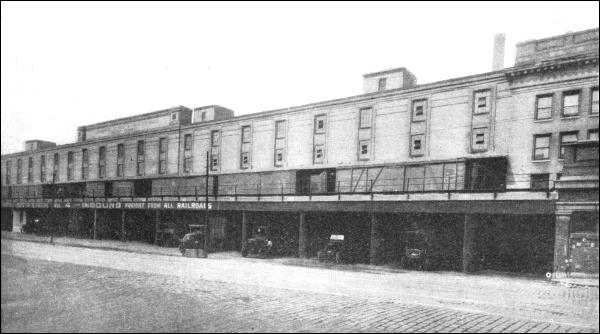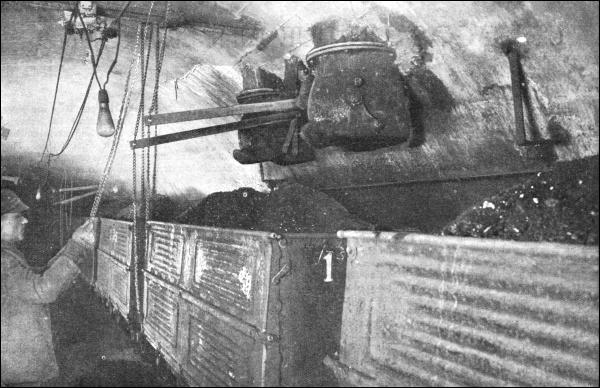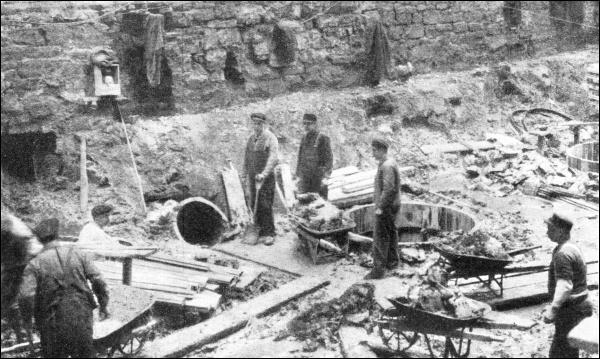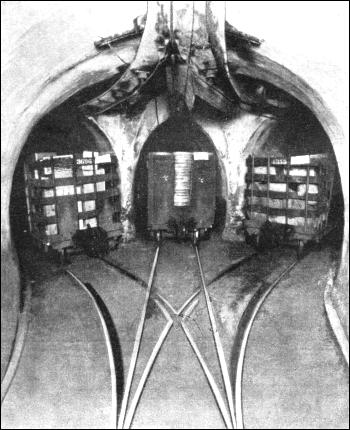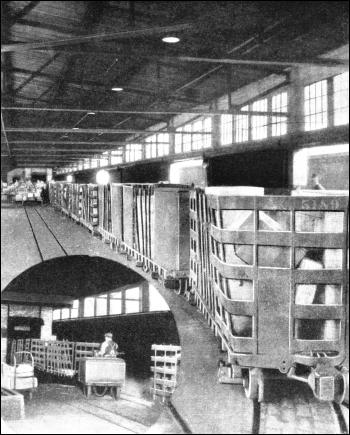|
|
Chicago is a city of striking architecture. Seen from Lake Michigan it presents a view of towering skyscrapers and handsome buildings. Situated at the cross-roads of much of the travel and commerce of the United States, it is particularly fortunate in its transport facilities, as it is the meeting-point of many railways. But if Chicago is a wonderful city above ground, it has also a wonderful network of tunnels underground such as is possessed by no other city in the world. These tunnels are used for transferring goods between business houses and railway depots, for removing refuse and excavated material from building operations outside the city, and for delivering coal to the huge business and office premises situated in the city itself. The tunnels were originally constructed at the beginning of this century by the Illinois Telephone and Telegraph Company for carrying telephone and telegraph cables. But after about twenty miles of tunnel had been made funds were exhausted. The concern was sold to a new company, the Illinois Tunnel Company, which obtained powers to handle merchandise and package freight between stores, warehouses and delivery points. Later a new company, the Chicago Warehouse and Terminal Company, was organised for the purpose of building tunnels under railway and private property, with connecting shafts and elevators to railway freight depots, business premises, and universal freight stations. After about $25,000,000 had been expended and some sixty miles of tunnel had been constructed, it became apparent that receipts could not meet the interest charges. Yet another company, the Chicago Tunnel Company was therefore formed. with increased capital, to operate jointly with the Chicago Warehouse and Terminal Company. This arrangement came into force in May, 1912. The tunnels are forty feet under the surface of the streets. They are below the sewers, and below the mass of pipes, cables, wires, and conduits which are essential to a modern city. They are unheard, as well as unseen, and are apparently known to few beyond those whom they serve. Some of their chief advantages - the relief of traffic congestion in the streets, for instance - are incalculable. They would have to cease operating to be missed. and may be compared with a public service which does its work so well that it causes no trouble.
There are now, approximately, sixty-two miles of tunnels and connections, all equipped with track of 2 ft. gauge, and with overhead trolley wires from which the electric locomotives take their power. The tunnels are 6 ft. wide inside and 7 ft. 6 in. high, the walls being faced with concrete a foot thick. It might be expected that these long, dim corridors would he damp and misty but they are dry, cool, and airy. As a provision against dampness, there are sixty-three electric pumps, with a complete system of pipes and 1,000 sumps from which any accumulation of water is raised to the sewers above. The tunnel floors are dry and clean. Waterproof and fireproof doors are provided to isolate connections with buildings and terminals in the event of fire, or of entry of water from above. Currents of air, rushing to the shafts, are stirred by the trains in their passage and blow with chilling vigour from the river drifts. The temperature is practically constant at 55 degrees Fahr. Scientific tests have shown that the air in the tunnels is remarkably pure. It is even drawn up through shafts for the ventilation and cooling of many theatres and other buildings. The rolling stock used in the tunnels consists of 150 electric locomotives and about 3,500 freight trucks of all kinds. The ordinary truck is fitted with stakes and bands to protect the load. It is about 4 ft. wide and 12 ft. long, and will carry from 1 to 6 tons, according to the commodity. Coal trucks hold 4 tons, and those used for the disposal of excavated material and cinders hold 3½ cubic yards.
A train dispatcher in the central station controls all train movements. He has over 300 telephone connections with the tunnels, and keeps a regular sheet of train locations and movements. The tunnels are lighted at all connecting points and elsewhere when other than train lights are needed. Signals protect the trainmen when delivering or switching trucks. Glass reflectors at all junctions give warning of an approaching train on another line, and electrically lighted signs announce "curve ahead" and warn the trainmen to "go slow" or "stop." There has never been a major accident in the tunnels. Motormen are thoroughly familiar with the right of way rules, and the tunnels are all "one way streets." Signs are placed showing the names of the streets above any part of the tunnels. Nothing in the way of safety appliances is wanting. Some idea of the volume of traffic created by trade and manufacture in Chicago may be gained from the fact , that over 70,000 horse vans, motor lorries, and delivery cars are engaged in carrying it, and a considerable part of the conveyance performed by these vehicles is to and from railway terminals. Freight is of many kinds, but is divided into two main classes, freight in bulk and package freight, or small lots. Package freight is subdivided into car-loads and less-than-car-load lots. The Chicago Tunnel Company is mainly concerned with the collection of package freight from the various warehouses and business houses within the city, and with its transference to the railway terminals for dispatch throughout the country. Conversely, the company takes packages from the railway terminals and delivers them to business places in the city.
Package freight comes in small lots of one hundredweight or less rather than in tons. It comes from everywhere and it goes everywhere. No fewer than 2,500 cars of it leave Chicago every day over twenty-eight railways for thousands of destinations. Probably an equal number of cars arrives every day from all over the country for delivery in Chicago. The collection of this small freight, consisting of thousands of consignments, involves many operations, before the 2,500 cars are ready to proceed on their journey. Through Chicago also, a great railway centre where many railways end or begin, there are transferred from railway terminal to railway terminal thousands of consignments, many of which go through the tunnels and many through the streets. About 2,000 tunnel trucks of freight are delivered to the various railway terminals every day, and 800 trucks are loaded for delivery to local consignees and other railways. In the course of one year the Chicago Tunnel Company delivers to railway freight terminals about 600,000 tons of package freight - enough to load approximately 100,000 ordinary freight wagons. Of the larger commercial houses in Chicago, twenty-four have direct individual connections with the tunnels. These connections consist of tunnel approaches, switches, tracks, shafts, and elevators for lifting the tunnel trucks to the level of the street floors. With one exception, these are used only for the dispatch and receipt of freight conveyed through the tunnels to and from railway freight terminals. The connections have been in use for a long time, and are as much part of the shipping facilities of these commercial houses as their own packing and dispatch rooms. Reliance on the tunnels is so great that no provision is made on the premises for the loading of horse or motor vehicles of any kind. Tunnel service is practically indispensable to the great warehouses also, whose storage space is necessarily supplemented by dispatch facilities. These great warehouses are at once the cause and result of Chicago's preeminence as a market and distributing centre. For instance, tunnel trucks run the entire quarter-mile length of the warehouses of the North Pier Terminal Company. Besides supplying storage space, all the warehouse buildings are occupied by tenants and manufacturers. The tunnel service is considered a distinct advantage both to the warehouse company and to its tenants, and it ranks about equal to all their other facilities. The use of the tunnels brings advantages which are expressed in terms of cash as well as in the saving of time and labour. Tenants have been attracted to the warehouses by their desire for tunnel service. One large concern dispatches an average of 100 tons daily through the tunnels to different railways. A department store has now substituted, the tunnel method for the sub-station delivery system used by a number of the larger central business stores. By the latter system package freight is carried direct from the stores in large capacity lorries to a sub-station or depot, and thence sorted and delivered by light motor vans. The tunnel service. however, obviates the one-mile journey through the busy streets to the sub-station, the delays during which formerly nullified much of the saving accruing from semi-mechanical collecting and loading at the store and the superior facilities for sorting at the sub-station. In the process of collecting for dispatch by railway the freight of each sender does not go to a single terminal or in one direction only. One sender may dispatch goods in all directions and over many railways. Motor lorries collecting freight may visit half a dozen terminals, and all these journeys add to the congestion of the already congested streets. Every consignment taken off the streets, therefore, reduces the wastage caused by congestion and delays. The tunnel method helps to lower the cost of distribution and cuts down waste.
The underground freight tunnels not only reduce street congestion, but also eliminate street and pavement wear, and reduce the volume of noise and dirt. They offer sanitary advantages in the movement of food and perishables, because they are clean, and the air in them is pure and of even temperature. In their economic aspect the tunnels are an integral part of Chicago's great scheme of trade and transport, and they are savers of time, labour, and money. They have long been contributing their share towards the solution of the great traffic problem by reducing the movement of freight. The central business district of Chicago, the square mile known as the "loop," is not only the centre of retail, wholesale, administrative, and terminal facilities community, but its streets must also carry a large volume of through traffic moving from one part of the city to another. With wholesale, retail, and manufacturing concerns showing the heaviest concentration in this district, it follows that the largest movement of package freight is in this "loop," under whose streets the freight tunnels run. There are, for instance, stores on State Street that have a door traffic of more than 100,000 customers each in a business day, and the few stores in this street possessing sub-station deliveries distribute over twenty million packages in Chicago and suburbs in a year. The congested condition of Chicago's "loop" makes it difficult for business to proceed; it runs up the City's bill for delays to an enormous amount daily. Every remedy for the congestion brings forth objections and every plan involves vast expenditure. Further, while the work of relief goes on, the volume of business and the number of people in the area increase, so that the measures of relief are always a little behind the growth. The freight tunnels have long been contributing their share towards the solution of this great traffic problem by reducing the movements of freight, and making them easier and shorter. They have expedited the collection of freight by systematisation, and have reduced to a great extent the delays through the congested streets of the "loop," A tunnel truck carries about the same load as a motor lorry. In the tunnels there is an average of about 300 trains a day, and a train is composed of from ten to fifteen trucks. The movement of freight in the tunnels is equal to about 5,000 motor lorry movements in the streets, and therefore by reason of the existence of the tunnels street traffic is reduced by 5,000 vehicle loads, thus considerably relieving congestion. Coupled together, the trains that pass through the tunnels each day would extend over ten miles. Motor lorries, carrying the same amount of freight, would, if allowance is made for the usual spacing between them, stretch along the streets for something more than three times that distance. In the absence of the tunnels there would be added to the street traffic in the "loop" and immediate vicinity a line of motor lorries thirty miles in length. The tunnels run under nearly every street in the "loop" district, from the river as far south as 16th Street. They run south under the Illinois Central Railway yards, north of the river, which is crossed eleven times, and west under the manufacturing and business districts. They bring their service to the door of factory, store, and warehouse where they deliver, and collect freight that comes from, or goes to, every part of the world. No other city has a system of freight collection and delivery comparable to this, in its efficiency or in its silent, clean, safe, and unobtrusive character. Another positive relief to street congestion is the underground delivery of coal through the tunnels. Many commercial houses and office buildings have tunnel connections only for coal and cinder service. Tunnel delivery of coal is without noise or dirt. It is trustworthy and costs no more than the normal method. Tunnel coal trucks are loaded at the railway depots through chutes from above and travel underground to the large buildings of the city, where conveyers receive and carry the coal to the furnaces. One large firm of coal merchants has the tunnel service in its yard, and makes its "loop" deliveries through the tunnels. In the same way cinders and ashes from the furnaces of hundreds of large buildings are conveyed through the tunnels, which offer an excellent method of disposing of such material. The Tunnel Company's disposal station is at Grand Avenue, on the north branch of the river, where cinders and clay are loaded in barges and towed thirteen miles out into Lake Michigan for dumping. Refuse of this kind is used also for making up land for building and for reclaiming land from the lake. The celebrated Field Museum is built on ground which was made from cinders and excavated material hauled through the tunnels. Over a hundred acres of the new park along the lake front were filled in with material brought through the tunnels at no cost to the city authorities. The whole of the ground on which the Chicago World's Fair of 1933-4 was built, over three and a half miles in length, was made up of such material on land reclaimed from the lake. The daily average tunnel load of material from new building excavation and from furnaces is between 200 and 300 trucks; but this, of course, varies with the amount of building in the central business district, and with the seasons. Sometimes the disposal of clay is 400 trucks a day for several months. In one year the tunnels conveyed 74,000 trucks of excavated material. Large sums have been expended in the provision of private connections with the tunnels that give stores, warehouses and railway terminals underground freight facilities, so that the tunnel service has become an integral part of Chicago's system of distribution. A firm which has a private connecting line with the tunnels loads tunnel trucks in its warehouse, whence they are lowered by lift to the tunnel level. This traffic amounts to 170,000 tunnel truck loads, or about 150,000 tons. Firms without such private connections deliver their freight to one of the four public receiving depots, known as Universal Freight Stations. These are outside the "loop," but each of them is sited with a view to business from that district. At these Universal Freight Stations the freight received for forwarding over the various railways, which amounts to 290,000 tunnel truck loads, or about 319,000 tons, is sorted by the tunnel staff, and delivered to the particular railway or railways concerned. Freight handed in at any of the Universal Freight Stations by 2 p.m. is passed over to the railway, and loaded before 5 p.m. in one of the 2,500 package freight cars which leave Chicago daily. Formerly the tunnels were used, similarly to the Post Office Railway, in London, which runs between Paddington and Mount Pleasant, for the conveyance of mails between the Post Office and railway stations, and may be so used again. The pneumatic tubes which carry messages from the offices of the City Press Association to daily newspapers already run through the tunnels.
Many thanks for your help
|
   Share this page on Facebook - Share  [email protected] |

